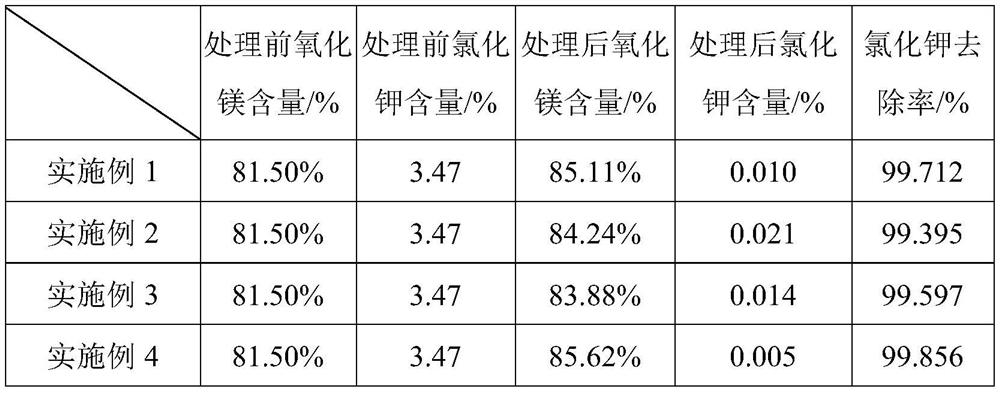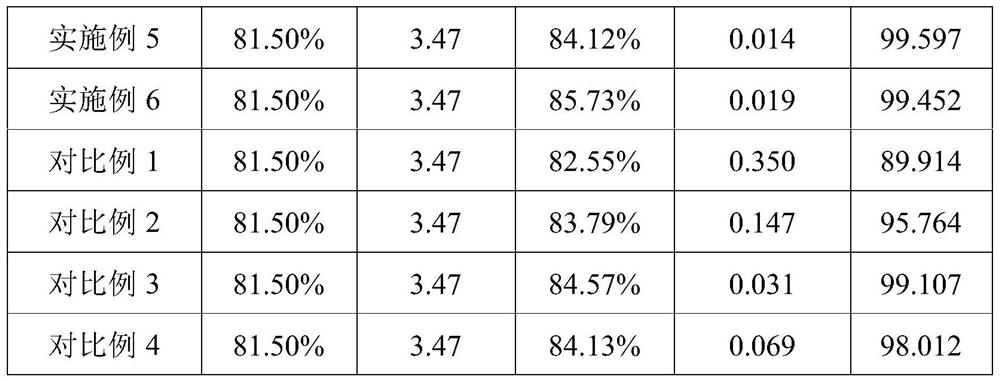Method for removing potassium chloride in bricks used for cement kiln
A cement kiln and potassium chloride technology, which is applied in the field of removing potassium chloride from bricks used in cement kilns, can solve the problems of unsuitable potassium chloride removal treatment and complex process, and achieve low treatment cost, simple treatment process, and solution The effect of polluting the environment
- Summary
- Abstract
- Description
- Claims
- Application Information
AI Technical Summary
Problems solved by technology
Method used
Image
Examples
Embodiment 1
[0020] A method for removing potassium chloride in cement kiln bricks, the method may further comprise the steps:
[0021] (1) Remove the metamorphic layer on the surface of cement kiln bricks (periclase-aluminum spinel bricks for firing zone) by manual selection, and coarsely crush the selected cement kiln bricks to 10-20mm, and then crushed to <0.5mm by a cone crusher or a double-roll crusher, and then ground to 0.074-0.044mm by a vertical mill to make a powder (potassium chloride content 3.47%, magnesium oxide content 81.50%);
[0022] (2) At room temperature, 0.05-1mol / L nitric acid (0.05mol / L nitric acid 2kg), 0.05-1mol / L organic acid (0.15mol / L citric acid 3kg) are formulated into a compound acid solution according to a mass ratio of 1:1.5;
[0023] (3) After mixing the powder obtained in step (1) and the compound acid solution prepared in step (2) according to the mass ratio of 1:2 (2.5kg of powder, 5kg of compound acid solution), soak at 25°C for 24 hour, the mixture...
Embodiment 2
[0027] Step (1) is with embodiment 1;
[0028] (2) At room temperature, mix 0.05-1mol / L nitric acid (0.5mol / L nitric acid 1kg), 0.05-1mol / L organic acid (0.5mol / L citric acid 5kg, 0.1mol / L tartaric acid solution 2kg) according to mass ratio 1: 7 is prepared into compound acid solution;
[0029] (3) After mixing the powder obtained in step (1) and the compound acid solution configured in step (2) according to the mass ratio of 1:3.2 (2.5kg of powder, 8kg of compound acid solution), soak at 25°C for 24 hour, the mixture was obtained;
[0030] (4) The supernatant liquid of the mixed solution obtained in step (3) is removed, and the sediment is repeatedly rinsed and filtered 3 times (15kg water) with tap water, and the sediment after filtering is at 110° C. Dry for 24 hours to obtain fine powder of regenerated multiphase magnesia.
[0031] The content of potassium chloride in the sample is detected by X-ray fluorescence to be 0.021%, the content of magnesium oxide is 84.24%, an...
Embodiment 3
[0033] Step (1) is with embodiment 1;
[0034] (2) Mix 0.05-1mol / L nitric acid (1mol / L nitric acid 2kg), 0.05-1mol / L organic acid (1mol / L citric acid 5kg, 1mol / L malic acid 1.5kg and 0.5mol / L tartaric acid 1.5kg) at room temperature ) is mixed with compound acid solution according to the mass ratio of 1:4;
[0035] (3) After mixing the powder obtained in step (1) and the compound acid solution prepared in step (2) according to the mass ratio of 1:4 (2.5kg of powder, 10kg of compound acid solution), soak at 25°C for 24 hour, the mixture was obtained;
[0036] (4) The supernatant liquid of the mixed solution obtained in step (3) is removed, and the sediment is repeatedly rinsed and filtered 5 times (20kg water) with tap water, and the sediment after filtration is at 110°C in a drying kiln or an oven. Dry for 12 hours to obtain fine powder of regenerated multiphase magnesia.
[0037] The content of potassium chloride in the sample is detected by X-ray fluorescence to be 0.014%...
PUM
| Property | Measurement | Unit |
|---|---|---|
| clearance rate | aaaaa | aaaaa |
| clearance rate | aaaaa | aaaaa |
| clearance rate | aaaaa | aaaaa |
Abstract
Description
Claims
Application Information
 Login to View More
Login to View More - R&D
- Intellectual Property
- Life Sciences
- Materials
- Tech Scout
- Unparalleled Data Quality
- Higher Quality Content
- 60% Fewer Hallucinations
Browse by: Latest US Patents, China's latest patents, Technical Efficacy Thesaurus, Application Domain, Technology Topic, Popular Technical Reports.
© 2025 PatSnap. All rights reserved.Legal|Privacy policy|Modern Slavery Act Transparency Statement|Sitemap|About US| Contact US: help@patsnap.com


